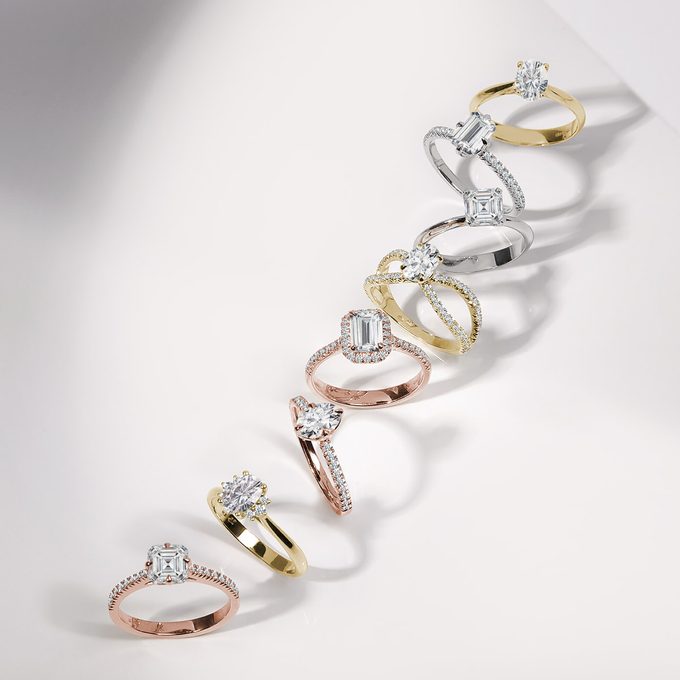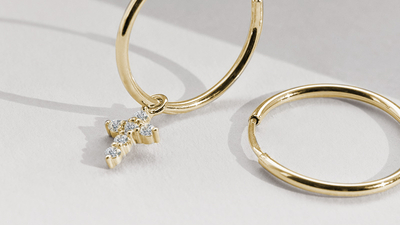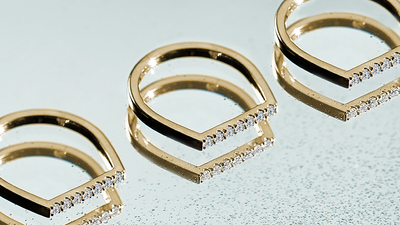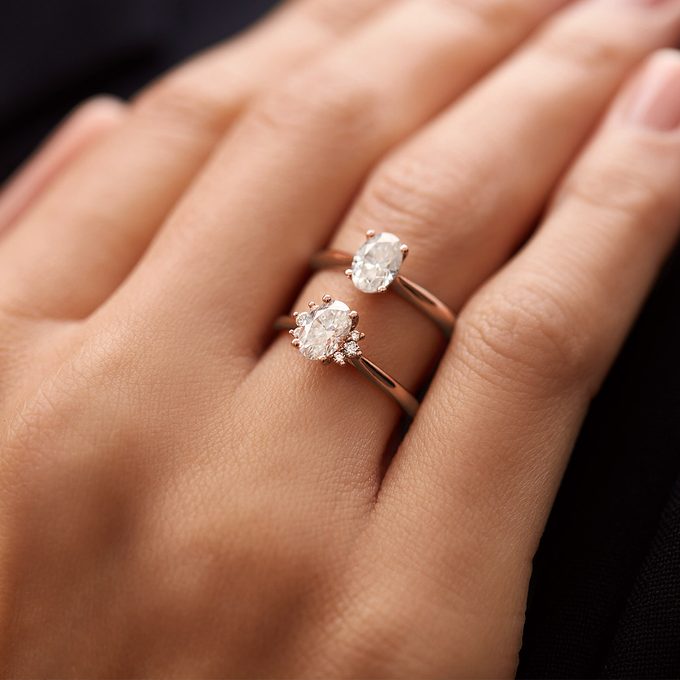Lab grown diamonds represent, without exaggeration, a new era for diamond jewelry. Their history began several decades ago and they have only just entered the world of jewelry making. They are diamonds which are intentionally man-made. But right from the start, it needs to be emphasized that these are real diamonds, which are just as beautiful and durable as natural diamonds. In this article, you'll find out about what makes lab grown diamonds special, how you can recognize them, and how they are created.
The properties and characteristics of lab grown diamonds
When it comes to most parameters, natural and lab grown diamonds are exactly the same. A person wouldn't know the difference at first glance, not even under a magnifying glass. The tell-tale features of lab grown diamonds can only be detected by an experienced geologist in laboratory conditions.
Natural and lab grown diamonds don’t differ in terms of composition (both are made of carbon), hardness (they both reach the highest grade on the Mohs scale, which is a 10) or other physical and optical properties. They are both equally fragile and cleave perfectly. They are also identical when it comes to the assumptions about the quality of their brilliance, sparkle and luster. In fact, they only differ when it comes to their origins and the length and manner of their crystallization and age.
The most important indicator as to whether or not the diamonds have been grown in a lab is the way in which the crystals formed. This is because the growth in a crystal system leaves invisible lines and other traces in the structure of the stone - it is therefore possible to determine whether a diamond is of natural or laboratory origin by the shape of the crystal.

The advantages of lab grown diamonds
Lab grown diamonds have a number of advantages that are definitely worth considering. The process of laboratory synthesis is much shorter compared to natural creation, which is a huge plus.
Related to this is undoubtedly the most attractive advantage of lab grown diamonds and that is their price. They can usually be bought for 20-30% less than diamonds of natural origin. In some cases, the difference is as much as 50%. Lab grown diamonds thus open the door to the possibility of owning a large, top quality transparent stone. In addition to their size, we also get perfect clarity and internal structure for a good price. And price is often the main and only obstacle when deciding which gemstone to buy, especially when choosing an engagement ring. Thanks to lab grown diamonds, a ring with a larger, distinctive diamond no longer has to cost in the tens of thousands.
Another attractive advantage is the possibility to "mix in" the desired color for the stone during lab synthesis - lab grown diamonds don’t have to be colorless at all. Color can be achieved by adding a certain chemical element during synthesis, or by irradiation or annealing after crystallization is complete. But the methods used in producing laboratory diamonds are constantly evolving with the main aim of making the resulting diamonds stand out in terms of clarity, brightness, colorlessness and size.
The environmental and sustainability elements of laboratory diamond production also certainly deserve mention. Laboratory synthesis is, among other things, more targeted; only a fraction of the diamonds obtained during mining are of a high enough quality suitable for jewelry. In the laboratory, the quality of the resulting stones can be significantly influenced.

Authenticating lab grown diamonds - what is the situation with certification?
You should always receive a certificate of authenticity with the jewelry you buy, which will tell you, among other things, important information about any stones which have been set into the jewelry. When it comes to any gemstones, the certificate must also contain information on whether the stones are of natural or laboratory origin. For each KLENOTA piece of jewelry with a lab grown diamond in it, you will receive a free certificate of authenticity issued by an international gemological laboratory.
When buying diamonds or diamond jewelry, you should always make sure that the diamond has its own unique number. You will find this on the certificate, but it is also laser-etched on to the girdle of the stone. You can then use this number to search for your diamond in an international database. This code, which is called an inscription, is burned onto the diamond by the laboratory that evaluated it and issued the certificate for it.
If you want to compare the price of two diamonds before you buy them, you should definitely choose stones that have been evaluated by the same laboratory. This is because some labs have slightly different grading scales or their grading is slightly influenced by their market interests, since they are directly connected to gem dealers. The most trusted labs are the GIA and IGI.
A brief history of laboratory diamond production
Since time immemorial, people have longed to find a way to make precious materials - ideally by transforming other, cheaper ones into them (alchemy and the charlatans who hung around the court of Emperor Rudolf II come to mind here). We now know that neither iron nor lead can create gold. And we also now know how to create diamonds in a laboratory.
At the beginning of the road to diamond synthesis stood the father of modern chemistry, Antoine Lavoisier. He discovered that the crystal lattice of a diamond corresponds to the crystal structure of carbon. And it was this discovery that launched the first attempts to create diamonds. Success already arrived in the late 19th century. In 1892, the French chemist Henry Moissan conducted an experiment: he simultaneously applied high pressure and high temperatures to carbon, thus accurately simulating the conditions under which diamonds form in nature. In this way, he succeeded in creating the first synthetic diamond.

Surprisingly, early efforts to create diamonds did not respond to demand from jewelers, but from industry. The tiny diamonds that started to be produced were well suited to lasers, communications technologies and microelectronics, but they were not suitable for gem cutting and jewelry making. However, with the development of the technology itself, it was finally the turn of jewelry making, and today diamonds are produced in a variety of sizes and colors and adorn many beautiful pieces of jewelry.
How are lab grown diamonds created?
Lab grown diamonds are now produced using two different methods: the CVD (Chemical Vapor Deposition) method and the HPHT (High-Pressure-High-Temperature) method. Both have one thing in common - you need a small piece of diamond to serve as the seed crystal. The resulting diamonds ideally fall into the IIa category, which is the rarest category occurring in nature. Only 1% of mined diamonds have this quality. In diamond classification, the IIa designation means that the stone is chemically almost or completely clear (that is, it contains no impurities in it). Such diamonds are not colored in any way, they are purely colorless.
CVD: The Chemical Vapor Deposition method
In this process, atoms of gas are layered onto a seed crystal - a small, thin slice of a polished natural or lab grown diamond. This is inserted into a reactor which is sealed and filled with a mixture of specific carbon-rich gasses (e.g. methane). Microwave radiation is then released into the reactor. This causes the gas phase to heat up to plasma form, to approximately 800-1200 °C. At that point, the carbon atoms completely separate from each other and then gradually diffuse towards the cooler diamond slice. They settle on it and the diamond slowly crystallizes.
The emerging diamond has to be stripped of the black non-diamond graphite layers that form on it as it grows. After it is polished, the crystal returns to the chamber for further growth. This is repeated several times during the crystallization process. The result is a flat, cubic, tabular crystal.
Multiple diamonds can be synthesized at one time using this method, but it depends on the size of the chamber and the number of seed plates. The crystal growth however takes a little longer, 3 to 4 weeks, due to the cleaning process. The size of the chamber and the exposure time also affect the size of the end diamond. The resulting crystals may have a brown coloration that can be removed by annealing. The CVD method generally uses lower temperatures and pressures than the HPHT process.

HPHT: The High-Pressure High Temperature method
This method of diamond production is older and is closer to replicating the conditions under which diamonds naturally form. There are three different types of press designs used in this production principle: the belt press, the cubic press and the split-sphere (BARS) press. These press designs are usually part of a high-pressure hydraulic press machine.
The starting point is once again a small piece of diamond which is placed inside a special chamber together with a metal catalyst and a piece of carbon in the form of graphite. Transition metals that have a high melting point, such as manganese, cobalt, nickel or iron are used as the catalysts. The growth chamber is then heated to temperatures of up to 1500 °C and pressure of 50-60 kbar (these values may vary slightly depending on the type of device). The metal melts and dissolves the carbon, which then migrates to the cooler diamond seed crystal, and diamond growth then occurs.
With the BARS press, the pressure is applied to two sets of parts or anvils which together form the split sphere. The first, outer set is made of steel and has 8 parts. When folded into a sphere, a cavity is formed in the middle in the shape of an octahedron. Inside it is a second, inner set of 6 anvils made of graphite. These form the central, cubic cavity in which the diamond crystals grow. However, this cavity is smaller than that of the belt press, so smaller crystals are usually produced through this method.
A 1 ct diamond formed using the belt press design takes a minimum of five days to grow. However, crystallization by HPHT can also take several weeks. It all depends on the desired diamond size and the size of the chamber. It used to be a big issue to produce a truly colorless diamond, as only a small presence of nitrogen in the reactor resulted in a yellowish color. However this has been resolved and now beautiful colorless crystals are produced via this method.
Determining the origin of the crystals: the telltale signs
Due to the different ways that natural, CVD and HPHT diamonds grow, it is possible to determine the method by which a crystal was formed. For this the growth lines and the different, often more pronounced fluorescence are examined. Lab grown diamonds can also phosphoresce (glow even after a lamp which has been shining on them is turned off), which natural diamonds don’t do.
Possible inclusions caused by the flow of the molten graphite and metals are also investigated. Metals that don’t enter the reaction as catalysts could in fact enter the crystal and remain in it. They then appear as black spots and from a different angle they have a metallic luster. In CVD diamonds, any possible inclusions are made up more of graphite, which is also black but which does not show a metallic luster.
The distribution of colors within a crystal can also be an important determining factor. In HPHT crystals, unless it’s a clear diamond, it’s possible to see geometric color zoning caused by the concentration of elements as the crystal grows. In CVD diamonds the color distribution tends to be uniform. Diamonds of natural origin may also exhibit color zones. However unlike HPHT crystals, they will not be geometrically arranged but random.
An indicator as to the origin of a diamond can also be the presence (and especially the combination) of elements that are in the crystal and that usually color the diamond in some way. This is because some elements don’t occur naturally together in such a way.

Another important telltale sign is the deformation of the crystal lattice. This is examined using polarizing filters. In natural diamonds, the lattice is often deformed in a mosaic structure because the diamond has to make a long and hard journey to the Earth's surface, during which it is subjected to different pressures from different sides. In HPHT diamonds, we don’t see much deformation because the pressure is applied evenly from all sides during the formation of the crystal. In CVD diamonds, we see deformation patterns more in the form of streaks.
However not all diamonds have to show differences in all categories. It’s therefore important to analyze as many characteristics of the diamond as possible to accurately determine the origin. The shape of the original crystal is the fundamental identifying feature. Natural diamonds have the shape of an octahedron; the growth of the crystal took place on eight different crystal faces, that is, in eight directions. The CVD method uses a thin square of diamond as its seed, so the crystal grows on only one face, resulting in a flat tabular crystal. HPHT diamonds have cubic growth surfaces in addition to octahedral ones.
The independent American GIA laboratory has a huge database of various diamond crystals and their gemological characteristics, which is a great resource for them when they determine the origins of diamonds and how the diamonds were formed. The laboratory also has its own diamond CVD machine which provides additional information and improves the process of determining the origins of diamonds. The GIA owns highly technologically advanced equipment that allow it to reliably test even very small diamonds.
A few interesting facts to end with
The IGI lab issued a certificate for a lab grown diamond that weighed 14.6 ct after it was cut, making it one of the largest diamonds created by the CVD method. It was certified as type IIa, which is fairly typical for this type of diamond. Its color was graded as an F and its clarity as VS2. It was cut into an emerald cut measuring 13.5 × 13.2 × 8.93 mm. It was made by Ethereal Green Diamond, a Mumbai-based company. The diamond is called the Freedom of India.
We mentioned above that metals added as catalysts to the HPHT reactor can sometimes enter the diamond crystal and remain trapped in it. These then become classic inclusions that appear as black spots. However what’s interesting is that if there are more of these metallic inclusions in the crystal, the diamond may react to magnets and be attracted to them.
So even diamonds have their chameleons. There are natural diamonds that change color depending on the external heat or lighting environment. Most often from green to yellow and less often the other way around. But the GIA also had the opportunity to examine a diamond created by the HPHT method which was classified as Fancy Vivid Pink. This diamond changed from pink to orange when exposed to short-wave UV light. But within a few minutes, its original color returned.
Quite simply, lab grown diamonds can hold a lot of surprises. Who knows what new ones they still have in store for us and what possibilities they will offer in the future.





































